![]()
The Ember gene eE.
Heterozygous
ember with
wild type ( eE//E
) is a normal blue phenotype with their single eE
gene hidden
by the dominant
affects of wild type. On the other hand, heterozygous ember and
recessive red (
eE//e)
leave their nest looking very much like normal recessive
reds. However, as adults they molt over the next two
years into
unimproved recessive reds and then into almost smoky blues but
retain a
glowing ember look in their wing shield pattern markings and wing
flight.
Many of these eE//E
loose
this red
look almost completely while others retain a portion of their recessive
red
look depending on other darkening factors being present. It
is this glowing
red color found in the shield markings and wing feathers with
their hot
ember look that vives this mutation its name. Bar pattern
birds tend to
retain less of the red color than do checkers or dark check
birds.
My experience is the more coarse spread pattern, the more red ember
color
remains. This may or may not always be true but thus far that
is what has
happened in my loft.
A poor recessive red or even an un-improved expression of recessive red remains what it is during both its juvenile and adult molts. They will not make this transformation from recessive red to un-improved or from un-improved into smoky blue with ember markings and flights. In addition, should a bird be heterozygous for both un-improved and ember then it naturally would start as an un-improved and molt into ember in just the same fashion as a normal recessive red / ember would since many un-improved recessive reds are simply just that, poor phenotypes of recessive red.
The
thing to remember
is that a heterozygous ember/ recessive red will start as a recessive
red
phenotype and molt into a typical ember; while a homozygous
ember//ember leaves
the nest as an ember and molt only slightly more towards the blue color
but
retains the smoky like blue shade with ember patterns and flights.
I
was
privileged to have
three Embers in my loft directly from Dr. Hollander. They
were given to
me by Larry Long. Larry is the pigeon flyer that first traped
a few
Embers from a flock of wild pigeons. When he first saw them
he knew they
were something different naturally Larry went about to captured and
test
them. He did this but was not able to pin down exactly what
it was so he
turned some over to both Dr. Paul Gibson and Dr. Willard F.
Hollander for
their independent genetic studies. What follows is a short
note I
received from Larry which I will share with
you.
Ronald
R Huntley
![]()
Hi
Ron,
Thanks for
explaining about Ember.
Doc called me this week and is still excited about Ember; he says it's
the
hardest project he ever took on. Yes, I did trap the first
Ember and Doc
wants me to tell that part of the story. What a lot of people
don't
realize is I bred out of the original feral and as I told Doc "didn't
understand what I thought I knew" I had never heard of an allele for
recessive red and didn't suspect that's what it was. I was
into homers
heavy back then and even made a test mating to a recessive red
homer. It
was only after I felt it was different and worthy of taking to Doc that
I
brought him the feral. When it finally died Doc dried the
wing.
He didn't
want to take on any new projects
because of his age but I talked him into crossing it on recessive red
and
trying it. When the babies came out recessive red he put them
in his cull
pen and forgot about them until he saw some bronzy looking odd balls
that he
didn't remember putting in the pen. When he checked his
records they were
the Ember crosses. He had almost gave up on the project so a
little luck
was involved. The key is they come out of the nest recessive red then
try to
revert or change back to wild type. One of my first questions
was what
about brown and ash red based Embers?
I believe
it's kept him young and his 90th
birthday is April 15th, Tax Day! This happens to be my
mother's birthday
too. Another strange coincidence is that October 23 is his
son Paul's and
my birthday! If nothing else Embers have gotten people looking at
recessive
red, unimproved recessive red (I don't like that term), and stuff
related to
recessive red a little closer. No, the genetic symbols aren't
right and
it bothers Doc but what can he do? I don't believe the story
is complete
yet on Embers and there is more to learn and new combinations to
try. I
believe it's going to lead to some beautiful color in
pigeons. I'm happy
that people like yourself has taken on this project with us.
Good Luck,
Larry Long
![]()
Well
after a few years
of breeding tests and observations by Dr. Hollander, Larry had
some of his
questions answered. He and Dr. Hollander were to publish
their findings
on this mutation but unfortunately Dr. Hollander passed away before his
report
was publication. It then fell on Larry to complete the review
of Doc’s
original draft report and to publish his findings. Unfortunately Larry
contracted cancer and he too passed away before he publish their
work.
What we do know of their findings is what we have from various emails
and
letters. General information, but lacking in technical
data. Today
ember is classified as a mutation and not a form of poor recessive red.
It shares the same e locus as recessive red
(symbolized as lower
case e) and therefore is an allele to it. Wild type
or non
recessive red is symbolized as upper case E or E+
or
even simply +.
Ember
is both a
recessive to the dominant wild type (normal gene found at this e locus)
while
at the same time, it is dominant over its recessive red
allele. For this
reason and and in keeping with the prescribed rules for genetic
symbols, Dr.
Hollander assigned Ember the symbol of eE
which denotes it to be
recessive to wild type (lower case e) but dominant to recessive red
(superscript capital E) . In short, the correct genetic
symbol for Ember
is eE.
In the attached pics,
note the difference in shades of blue between the typical blue bar on
the left
and the Ember blue bar on the right. Also, notice that the
ember glow is
retained in the course spread pattern markings. This means that the
darker the
pattern or the more pattern there is, the more ember color will be
retained in
the color transformation from recessive red to ember.
![]()
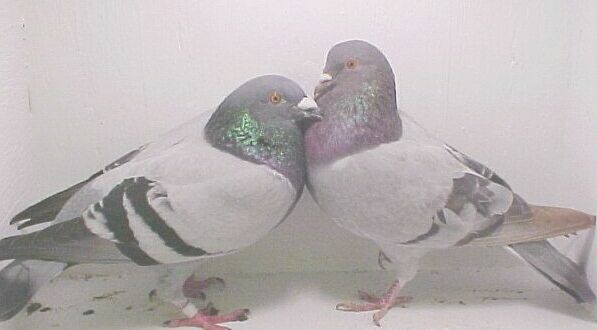
Normal blue bar / Ember blue bar 252 E
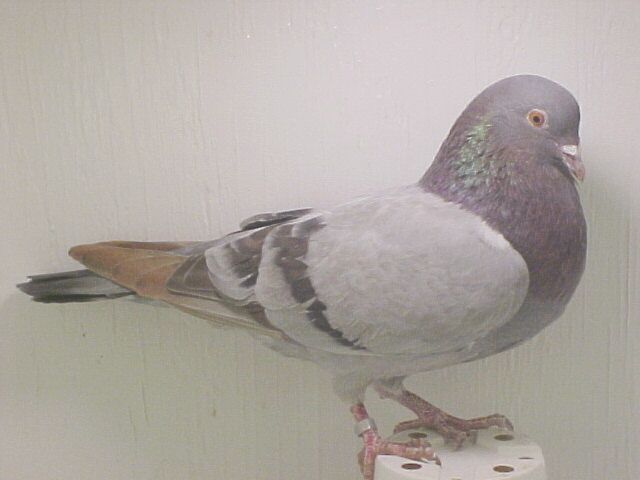
Ember blue bar 252 E Ember blue bar wing shield 252 E
The ember blue bar above, left his nest to began life as normal looking recessive reds. Back then he looked nothing like he does today. He has transformed through the molt from his juvenile recessive red phenotype to his adult ember phenotype. This transformation from recessive red into something else, is what makes ember so unique. There will be other phenotypes, as breeders of color combine this gene with other color mutations; produceing I'm sure some very striking birds.
![]()
AU03MEGA2111 A Young Recessive Red
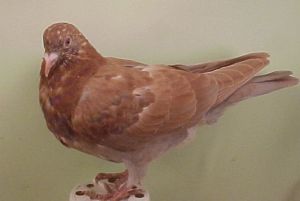
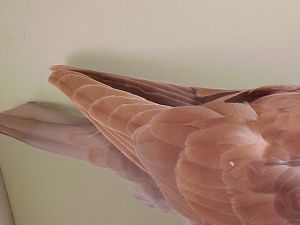
This first youngster AU03MEGA2111 may not be an Ember. eE//e. It shows no blue color and was a lighter shade of red in the nest than the other two young birds that follow. All three are siblings from the same pair. This first youngster appears not to have received an ember gene from its sire. Its dam does not carry ember. She is a typical recessive red. No. 2111 looks to be on its way to becoming a normal recessive red like her dam. Here is another photo of the wing shield taken two months later.
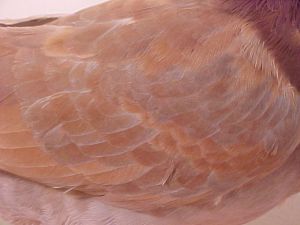
![]()
AU03MEGA2112 A Young Ember
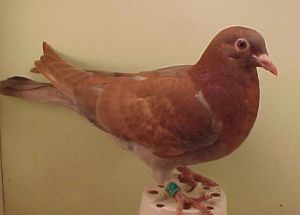
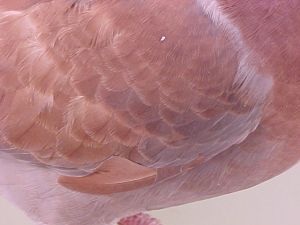
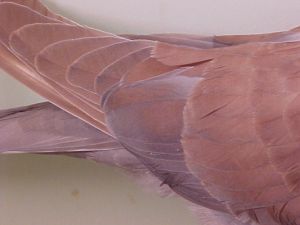
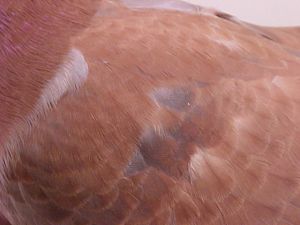


This bird No. 2112 may be a blue bar or blue checker ember. It has a dark tail bar and bluish colored back. There were some small signs of ember on the wing shield while still in the nest. There was not much differences between 2111 and 2112 while in the nest As 2112 molts, it will continue to revert to its normal blue color. However, it will not make a complete transformation to wild type. Some effects of the ember will remain to give it the glowing ember effect. I expect this bird to molt into a phenotype much like its sire 205E above. This next two photos were taken two months later and clearly show a large transformation has already taken place both across the back and over the wing shield.
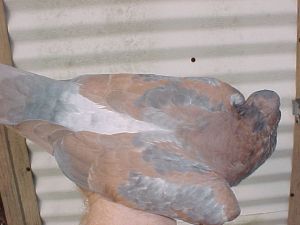
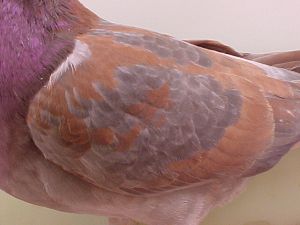

![]()
AU03MEGA2113 Young blue spread Ember
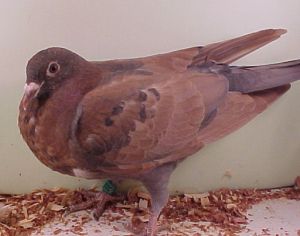
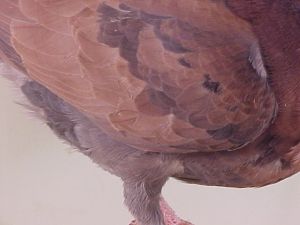

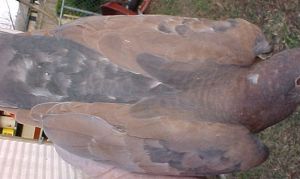
No. 2113 may be a Spread Ember as it continues to molt into a Mahogany color typical of blue spread ember. In the nest it was a much deeper red that the other sibling and it's back and tail were a dark mahogany in color. After fledging from the nest it began molting into a much darker color over its wing shield, back and head. The next two photos were taken two months later and show this same transformation continuing. This bird received it's spread gene from his mother.
The
last two photos were taken three weeks later. The
photo on the left shows more change. The one on
the right is with a normal recessive red to show the color difference
between them. This bird 2113 was taken by a hawk before it
could complete its transformation.
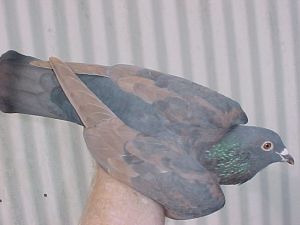
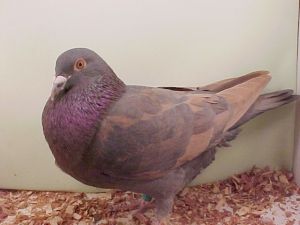
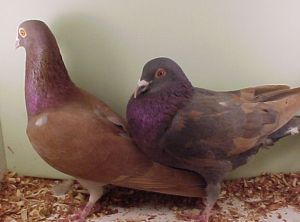
The first two photos were
taken when this youngster was about ten weeks old, it's molt had
already begun. The next two photos were
taken a few weeks later showing how the color change had progressed.
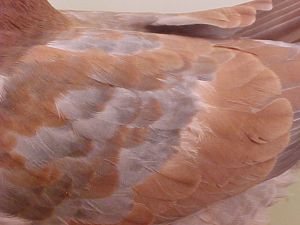
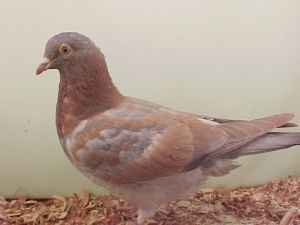
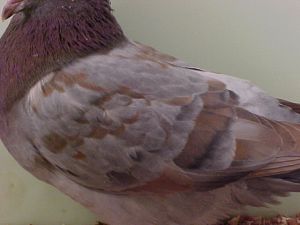
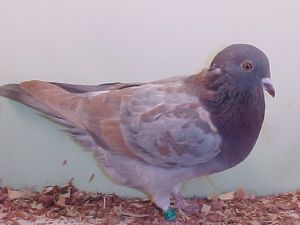


These
two photos
above show the final adult molt phenotype. Note the
change that has
taken place. It has gone from a typical juvenal recessive red
plumage
into a blue bar with a glowing ember look. It blue wing
shield is dark
almost like smoky but the tail has an albescent strip indicating it to
be non-smoky. The head and breast have the
purple tint
typical of intense gimpel yet it is not gimpel. The
wing tips and
tail feathers and bar pattern all retain the ember red color.
There are
other phenotypes that can be produced using smoky, gimpel and dominant
opal on
blue that will look very similar but these combination of mutations do
not go
through the color transformation that ember does.
![]()
My
friend James
Gratz is working with Embers which he also received from Dr.
Hollander.
James' studies are to learn what these various phenotypes will look
like. Some are very different from those shown
above which are
basic ember on blue patterns. For example, when combined with
dilute the
ember red turns to a golden yellow look. It is similar in
appearance to
what we find when we combine dilute with reds and
browns.
Below are four photos provided by James. Hopefully
he will continue
to pass along other photos as he produces the many various color
combinations. They will be very useful to all of us, in
learning more
about this new gene.
To
see a larger
photo just place your curser over the photo and right click you mouse
and it
will take you to a larger photo.
.
An
update from Dr. Gratz.
Below are two
photos of a homozygous or pure blue bar ember phenotype. It
has taken a few years of very selective
breeding to produce this bird as Dr. Gratz had to insure that is was
free as
possible of other darkening color modifiers.
Here in his words he explains
what he has done.
“Here is the cleanest ember I have made to date. Last year I mated a clean looking ember to a clean wild type homer hen. I produced several young, all of which looked like nice clean wild type. I mated the cock to one of his daughters. This bird is the result of that mating. He? has less bronze than his dad. Notice the light, recessive red like beak and nails. Ember beaks look the same as recessive red beaks in the nest. It has the smeary look like smoky has but is not smoky as it has a normal crisp albescent strip”
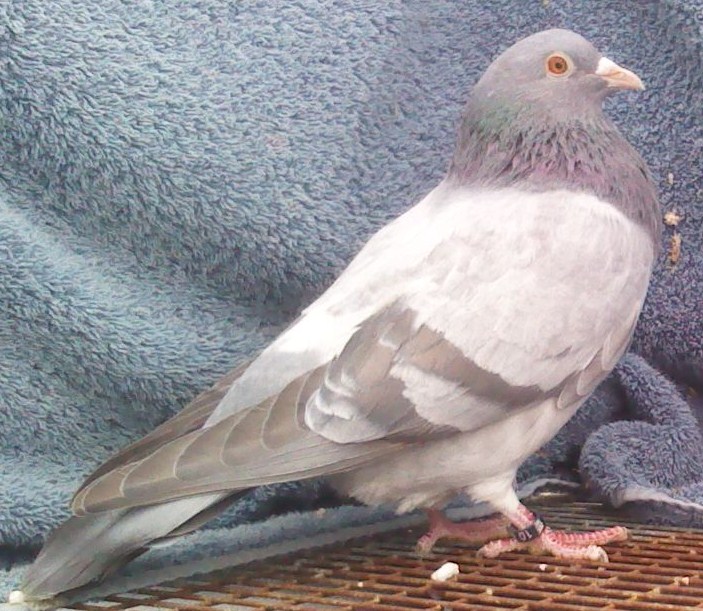
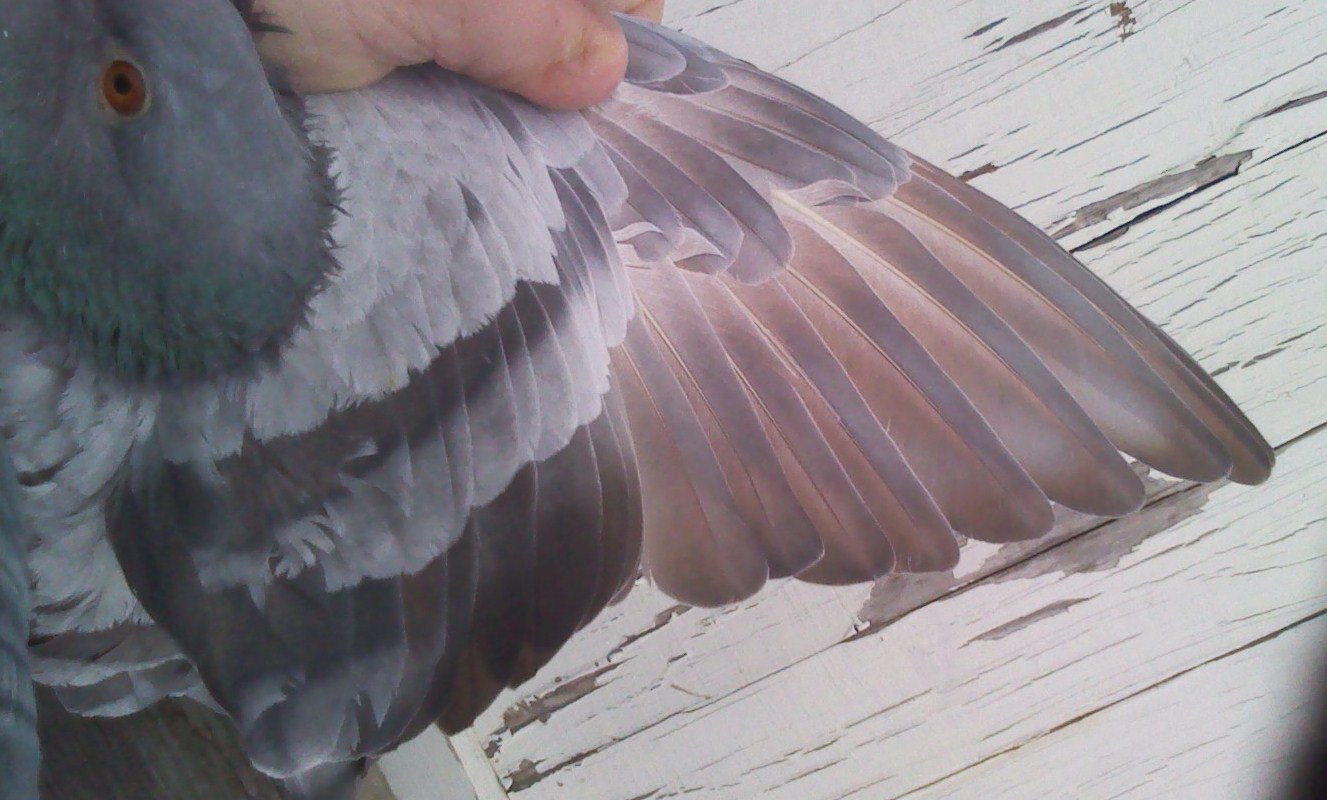
![]()